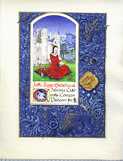 Gallery
1
Gallery
1
SCA Scrolls by the Scribes of Lochac
All images copyright 2003-2006. All artwork remains the property of individual artists, and may not be reproduced in part or in full in any medium without written permission from the artists.
![]()
Index of Artists
|
Beatrice Delfini |
Patent of Arms (Order of the Laurel) for Mistress Evelynne van der Haagen |
|
Caristiona nic Beathain |
|
|
Giles de
Laval
|
Patent of Arms (Order of the Pelican) for Mistress Catherine of Chester |
|
Patent of Arms (Order of the Laurel) for Mistress Branwen of Werchesvorde |
|
|
Patent of Arms (Order of the Pelican) for Mistress Eleanor of Caithness |
|
|
Patent of Arms (Order of the Pelican) for Mistress Filippa Ginevra Francesca di Lucignano |
|
|
Leofwynn Wulfinga |
|
|
Leonie de Grey |
|
|
Myfanwy of Aberystwyth |
|
| Madelaine de Bourgogne | Leaf of Merit for Lord Hirsh von Henford |
|
Nerissa de Saye |
|
|
Royal Patent of Arms for Duchess Juana Isabella de Montoya y Ramirez |
|
|
Richard de la Croix |
Patent of Arms (Order of the Laurel) for Mistress Juana Isabella de Montoya y Ramirez |
|
Rowan Perigrynne |
|
|
Rohesia le Sarjent |
|
|
Yseult de
Lacy
|
Patent of Arms (Order of the Laurel) for Master Dafydd of the Glens |
|
Patent of Arms (Order of the Laurel) for Master Arenwald von Haagenberg |
![]()
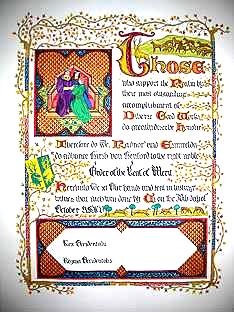 |
Leaf of Merit for Lord Hirsh
von Henford Madelaine de Bourgogne |
|
Patent
of Arms (Order of the Pelican) for Mistress Catherine of Chester Giles de
Laval Master Giles has also written an essay of the making, influences, and symbology of this beautiful scroll. Large image (450Kb). |
|
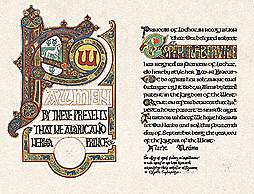 |
Royal Patent of Arms for Viscountess Elspeth of Turberville Nerissa de Saye This work is based on the Book of Kells and the Lindisfarne Gospels (8th century). The intricate illumination includes anthropomorphic and zoomorphic forms, as well as celtic interlace and geometric patterns, and incorporates the recipient's arms into the capital (view details of the illumination and the capital). |
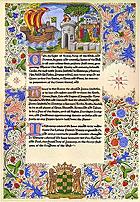 |
Royal Patent of Arms for Duchess Juana Isabella de Montoya y Ramirez (You Killed My Father, Prepare to Die) Nerissa de Saye, Inspired by late 15th century Spanish manuscripts. The miniature illumination shows the recipient embarking on her new estate as a Duchess, symbolised by setting sail in a ship (view detail). |
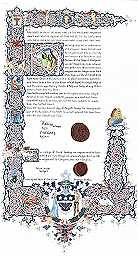 |
Patent of Arms (Order of the Laurel) for Mistress Evelynne van der Haagen Beatrice Delfini This is a magnificent example of the Renaissance Humanist style (also known as vermiculato or white vine) found throughout Italy in the 15th century, using letterforms and designs based on Classical and Ottonian texts. The intricate illumination contains references to the recipient's many skills and interests (view details of the capital, the arms and the illumination). Silver instead of gold was uised at the recipient's request. |
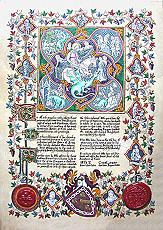 |
Patent of Arms (Knight) for Sir Inigo Missaglia Rohesia le Sarjent A magnificent manuscript in the international gothic style, based on the Bible Historiale, c. 1357. For a step-by-step progression of this scroll, click here. The miniature shows the story of St George: top left, the dragon ravages the country and eats all the sheep. Top right, the people draw lots to decide who will be fed to the dragon, and the Princess is about to draw the short straw. Centre, St George comes to the rescue. Bottom left, the subdued dragon is led into the city, and finally bottom right, St George slays the dragon and inspired by his courage the people become Christians. The border miniatures illustrate the seven knightly virtues. Clockwise from the left: measure, justice, courage, humility, loyalty, courtesy and magnanimity. Naturalistic grisaille portraits of the King and Queen of Caid flank the recipient's arms. The scroll was written with Chinese ink and illuminated with gold leaf, gold powder and period pigments on goat vellum. Red tones are made from brazilwood and dragon's blood, flesh tones are red ochre and zinc oxide with some egg shell. Blues are lapis lazuli, some with a little black nightshade juice. Greens are Malachite or veridigris, and some parsley juice. Yellow is made from saffron, white from zinc oxide. Paints were prepared by hand by the scribe, bound with gum acacia or glair; the raised gold work is laid on gesso. |
 |
Patent of Arms (Order of the Laurel) for Master Dafydd of the Glens Yseult de Lacy This scroll is painted on goat parchment
and has raised gilding on plaster-based gesso which has been inscribed with patterns of dots. The
hand is Gothic Textura Quadrata. |
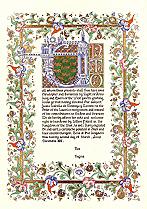 |
Patent of Arms (Order of the Laurel) for Mistress Juana Isabella de Montoya y Ramirez Richard de la Croix Based on the Visconti Hours, Italian 1325-13240. An ornate architectural capital encloses the recipient's arms, and is complemented by a stylised floral border. |
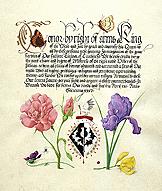 |
Patent of Arms (Order of the Pelican) for Mistress Eleanor of Caithness Giles de Laval Design and illumination inspired by the Mira Monumenta Calligraphiae (view details). |
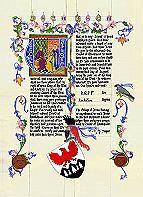 |
Patent of Arms (Knight) for Sir Torold of Hawkhurst Rowan Perigrynne Based on late 14th century Bohemian manuscripts such as the Golden Bull and the Wenceslas Bible. The historiated capital depicts the recipient swearing fealty to the King (view detail) and the form and delicate colouring of the foliage is peculiar to Eastern European manuscripts of this time. |
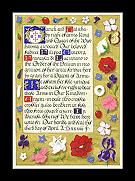 |
Patent of Arms (Order of the Pelican) for Mistress Filippa Ginevra Francesca di Lucignano Giles de Laval This manuscript is based on several early 16th century Flemish books of hours, in particular the Sloane and Hastings Hours. The text was written with quill. The border design is typical of the Ghent-Bruges school of illumination, depicting illusionistic, highly natural flowers and insects strewn on a luminous liquid gold background. Many of the flowers carry symbolic meaning, including the lily for purity, heartsease for devotion, speedwell for success, pinks for sacrifice and strawberry for good works. The recipient's arms are painted in the capital only 11mm high; the entire scroll measures only 15 x 10.5 cm. |
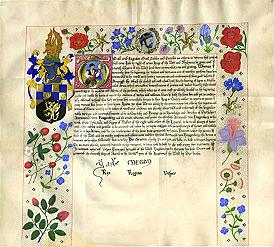 |
Patent of Arms (Order of the Laurel) for Master Arenwald von Haagenberg Yseult de Lacy This scroll is based on Elizabethan Grants of Arms, with a portrait of the recipient in the initial istead of the King of Arms giving the grant. A grisaille portrait of King Jade of the West occupies the laurel wreath at top centre. Goat parchment, W&N gouache, raised gilding on plaster-based gesso. In its finished state the bottom section of the scroll is folded up and tags with pendant seals are threaded through it. The patchwork effect is due to the scroll having been scanned in six sections and joined to make the whole piece--it measures about 50x40cm. (Parchment is difficult to scan evenly since it transmits and reflects light quite differently from paper.) |
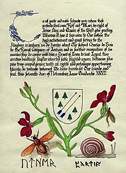 |
Grant of Arms for Lord Charles du Bois Caristiona nic Beathain Design and illumination inspired by the Mira Monumenta Calligraphiae, the last great manuscript produced in Europe for the Emperor Rudolf II, written in 1562 and illuminated in the 1590's. The Mira's illumination programme consisted of extremely naturalistic and illusionistic flowers, animals and insects; shown here are scarlet gillyflowers surrounding the recipient's arms, a common fly and a garden snail. |
 |
Patent of Arms (Order of the Laurel) for Mistress Branwen of Werchesvorde Giles de Laval In the style of the magnificent Winchester Bible, c1145. The historiated capital (view detail) has a raised gold border, and depicts a scribe with scroll and quill, and by her ear the dove of wisdom (also a play on the white raven in the recipient's Arms). The banner versals spell Laureatus (crowned with Laurels). |
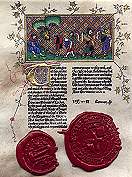 |
Leaf of Merit with Award of Arms for Sir Alaric of Bangor Nerissa de Saye In the style of several French manuscripts of the 14th century, including sources from the artist's collection. The manuscript on vellum features delicate gold foliage and pen-drawn embellishment, raised gold work and a detailed miniature of knights and squires at training. The entire scroll measures only 20 x 15 cm. |
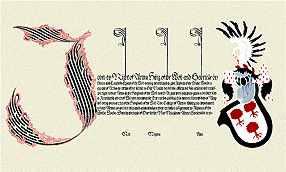 |
Grant of Arms for Mistress Isabeau of the Wilde Woode Giles de Laval This scroll is based on early 16th century German documents such as the Prayerbook of the Emperor Maximilian (1514) and Cardinal Wolsey's Letters of Credence (1527).The scroll features an intricate Cadel style capital with delicate pen-drawn filigree, German Fraktur script and the recipient's Arms. |
 |
Grant of Arms for Mistress Bryony Beehyrd Leofwynn Wulfinga Based on design elements from the Lindisfarne Gospels. (Detail of Arms/initial.) |
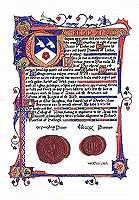 |
Award of Arms for Lord Richard de Montfort of Hastings Myfanwy of Aberystwyth The design is based on several manuscripts in the gothic style, mid-13th century. The illumination features extensive whitework and diapering, and a hunting scene in the upper margin (view detail of the capital). Chinese ink, gouache and shell gold on archival rag paper. |
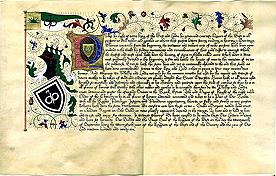 |
Patent of Arms (Knight) for Sir Snorri Ottarson Leonie de Grey Done with gouache and gold leaf on Kangaroo vellum. The apparent fold down the middle is caused by having to scan the grant in two sections. The illumination is based closely on a English Grant of Arms of 1492 (Richard III). The 1492 text was in French. This text is based on a English Grant of Arms of 1547 (Edward VI). |
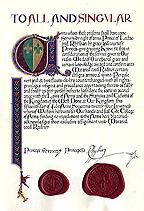 |
Award of Arms for Lord Marared coed Radnor Giles de Laval Based on the Winchester Bible, English c1145-1170. (Detail of capital) |
![]()
Home | Guildhall | Gallery 2 | Gallery 3 | Gallery 4 | Lectern | Library | Model Book | Vault | Almoner | Owlery
![]()
